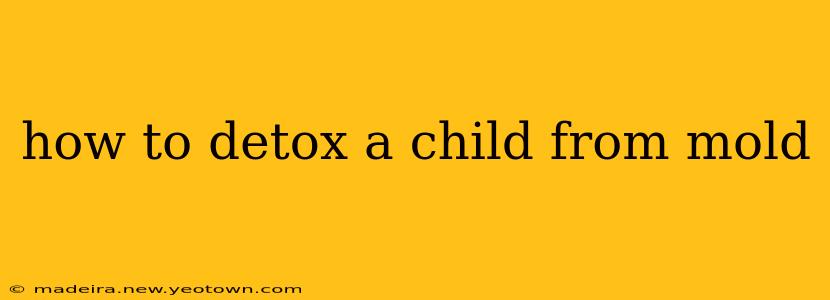How to Detox a Child from Mold: A Parent's Guide to Navigating Mold Exposure
Mold exposure can be a serious concern for children, impacting their health in various ways. This isn't about a quick fix, but a journey toward supporting your child's body in its natural detoxification processes. This guide offers strategies, but always consult with your pediatrician or a qualified healthcare professional before implementing any detoxification plan for your child. Their guidance is paramount in ensuring your child's safety and well-being.
This isn't about blaming yourself; mold is pervasive, and sometimes, despite best efforts, exposure happens. The focus here is on proactive and supportive measures. Let's explore some key aspects.
Understanding the Impact of Mold Exposure on Children
Children are particularly vulnerable to mold exposure due to their developing immune systems and smaller body size. Symptoms can range from mild allergies (like sneezing and runny nose) to more severe respiratory issues (like asthma exacerbations) and even neurological symptoms. The severity depends on the type of mold, the level of exposure, and the child's individual sensitivity.
Is My Child Showing Signs of Mold Toxicity?
This is a crucial question, and only a medical professional can definitively answer it. However, some common signs that might warrant a doctor's visit include:
- Persistent respiratory problems: Coughing, wheezing, shortness of breath, or recurring respiratory infections.
- Allergic reactions: Sneezing, runny nose, itchy eyes, skin rashes.
- Neurological symptoms: Headaches, fatigue, difficulty concentrating, memory problems, mood swings.
- Gastrointestinal issues: Nausea, vomiting, diarrhea.
What are the Best Ways to Detoxify My Child from Mold?
There is no single "detox" for mold exposure. It's about supporting the body's natural elimination processes and minimizing further exposure.
1. Identify and Eliminate the Source:
This is the most critical step. A thorough inspection of your home is necessary to identify and remediate any mold sources. This may involve hiring a qualified mold remediation specialist. Removing the source is far more effective than any detoxification strategy alone.
2. Improve Indoor Air Quality:
- Increase ventilation: Open windows regularly (weather permitting), use exhaust fans in bathrooms and kitchens.
- Use air purifiers with HEPA filters: These can help remove mold spores from the air.
- Maintain low humidity: Use dehumidifiers in damp areas to prevent mold growth.
3. Support the Body's Natural Detoxification Processes:
- Hydration: Encourage plenty of water intake to help flush out toxins.
- Nutrition: A balanced diet rich in fruits, vegetables, and whole grains provides essential nutrients for immune function and detoxification.
- Gut health: A healthy gut microbiome plays a crucial role in detoxification. Probiotics can be helpful, but consult your doctor before giving your child any supplements.
4. Consider Medical Interventions (Under Doctor's Supervision):
Depending on the severity of symptoms, your doctor might recommend:
- Allergy testing: To identify specific mold allergies.
- Medication: Such as antihistamines, corticosteroids (for inflammation), or other medications to manage symptoms.
What are Some Natural Remedies to Support Detoxification?
While natural remedies might offer supportive benefits, they are not replacements for medical advice or professional mold remediation. Always consult your pediatrician before using any supplements or alternative therapies on your child. Some parents find that a focus on nutritional support, as described above, is beneficial.
How Can I Prevent Future Mold Exposure for My Child?
Prevention is key. Regularly inspect your home for signs of moisture and mold. Address any leaks promptly, maintain good ventilation, and keep humidity levels low.
Remember: This information is for general knowledge and does not constitute medical advice. Always seek professional medical advice for your child's health concerns. Early intervention and a comprehensive approach, involving both environmental remediation and medical support, are vital in effectively addressing mold exposure in children.

